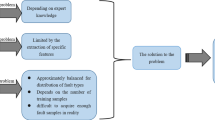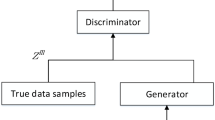Abstract
Faced with the problem of valid data shortage data in practical. There's not enough data to train classifiers which can be satisfied to detect impact-rubbing faults in rotary machine. Bedsides, the large number of noises in working enviroment make the useful signal contaminated. Based on this problem, this paper proposes a rubbing fault recognition method based on a generative adversarial nets named deep convolution generative adversarial nets (DCGAN), which is based on a deep convolutional network frame with generation and discrimination models. The acquired signal is processed by time frequency analysis further to get spectrogram. The DCGAN can perform feature conversion and map it to the potential feature subspace to obtain more robust features. The results illustrate that the proposed method can achieve a much more excellent recognition effect. Thus, the proposed DCGAN model is an effective way to recognize impact-rubbing fault in the practical.
Similar content being viewed by others
References
J. Li, A. Deng, Y. Yang, X. Cheng, D. Liu and L. Zhao, A new iterative near-field coherent subspace method for rub-impact fault localization using AE technique, Journal of Mechanical Science and Technology, 31 (5) (2017) 2035–2045.
A. Deng, H. Cao, H. Tong, L. Zhao, K. Qin and X. Yan, Recognition of acoustic emission signal based on the algorithms of TDNN and GMM, Applied Mathematics & Information Sciences, 8 (2) (2014) 907–916.
A. Deng, H. Tong, J. Tang, H. Cao, K. Qin and X. Yan, Study on location algorithms of beamforming based on MVDR, Applied Mathematics & Information Sciences, 7 (6) (2013) 2455–2466.
A. D. Deng, X. D. Zhang, J. N. Tang, L. Zhao and K. Qin, Localization of acoustic emission source based on chaotic neural networks, Applied Mathematics & Information Sciences, 6 (3) (2012) 713–719.
S. Al-Dossary, R. I. R. Hamzah and D. Mba, Observations of changes in acoustic emission waveform for varying seeded defect sizes in a rolling element bearing, Applied Acoustics, 70 (1) (2009) 58–81.
Q. Chen et al., Prediction of the transient energy response for complex vibro-acoustic systems, Journal of Mechanical Science and Technology, 33 (2) (2019) 495–504.
A. Morhain and D. Mba, Bearing defect diagnosis and acoustic emission, ARCHIVE Proceedings of the Institution of Mechanical Engineers Part J. Journal of Engineering Tribology, 217 (4) (2003) 257–272.
C. Li, J. Valente de Oliveira, M. Cerrada, D. Cabrera, R. V. Sánchez and G. Zurita, A systematic review of fuzzy formalisms for bearing fault diagnosis, IEEE Transactions on Fuzzy Systems (2018).
C. Li et al., A comparison of fuzzy clustering algorithms for bearing fault diagnosis, Journal of Intelligent & Fuzzy Systems, 34 (6) (2018) 3565–3580.
J. H. Park, J. U. Gu and N. S. Choi, Acoustic emission characteristics of methacrylate-based composite and silorane-based composite during dental restoration according to a variety of C-factor, Journal of Mechanical Science and Technology, 31 (9) (2017) 4067–4072.
L. Hang, Statistical Learning Method, Tsinghua University Press (2012) 17–18.
I. J. Goodfellow et al., Generative Adversarial Nets, Advances in Neural Information Processing Systems (2014) 2672–2680.
N. Killoran et al., Generating and designing DNA with deep generative models, NIPS 2017 Computational Biology Workshop, arXiv preprint arXiv:1712.06148 (2017).
T. Schlegl et al., Unsupervised anomaly detection with generative adversarial networks to guide marker discovery, Information Processing in Medical Imaging (2017) 146–157.
T. Kim et al., Learning to discover cross-domain relations with generative adversarial networks, arXiv preprint arXiv:1703. 05192 (2017).
A. Antoniou, A. Storkey and H. Edwards, Data augmentation generative adversarial networks, arXiv preprint arXiv:1711. 04340 (2017).
A. J. Bell and T. J. Sejnowski, An information-maximization approach to blind separation and blind deconvolution, Neural Computation, 7 (6) (1995) 1129–1159.
Y. Yong et al., Mine Water Inrush Sources Online Discrimination Model Using Fluorescence Spectrum and CNN, IEEE Access, 6 (2018) 47828–47835.
M. Arjovsky, S. Chintala and L. Bottou, Wasserstein gan, arXiv preprint arXiv:1701.07875 (2017).
S. Nowozin, B. Cseke and R. Tomioka, f-gan: Training generative neural samplers using variational divergence minimization, Advances in Neural Information Processing Systems (2016) 271–279.
A. Radford, L. Metz and S. Chintala, Unsupervised representation learning with deep convolutional generative adversarial networks, arXiv preprint arXiv:1511.06434 (2015).
J. Li et al., A new iterative near-field coherent subspace method for rub-impact fault localization using AE technique, Journal of Mechanical Science and Technology, 31 (5) (2017) 2035–2045.
Z. Q. Chen, C. Li and R. V. Sanchez, Gearbox fault identification and classification with convolutional neural networks, Shock and Vibration, 15 (8) (2015) 18–28.
Author information
Authors and Affiliations
Corresponding authors
Additional information
Conflict of Interest The authors declare that there are no conflicts of interest regarding the publication of this paper.
Recommended by Editor No-cheol Park
Wang Wei is Ph.D. candidate at School of Information and Control Engineering, China University of Mining and Technology, China. He received the B.E. degree (2006) from Nanjing Institute of Technology and the M.E. degree (2010) from China University of Mining & Technology. His research interests are in Control Theory and Control Engineering. Mobile: +86 13952182087
Weidong Liu is an Associate Professor at School of Information and Control Engineering, China University of Mining and Technology, China. His research interests are in Acoustic Emission Signal Processing and Neural Networks. Mobile: +86 188 0520 6588
Jing Li received the B.A. degree (2005) from Hebei University of Engineering, Handan, the M.S. degrees (2008) from China University of Mining & Technology, and the Ph.D. degree from Southeast University (2017). She is currently working at Nanjing Audit University. Her main research interests include signal processing, sensor array technology, artificial intelligent and modeling as applied to AE signal recognition applications.
Wei Peng received the B.E. degree (2002) and the M.E.degree (2010) from China University of Mining & Technology. He is currently pursuing the Ph.D. degree at China University of Mining & Technology. His main research interests include signal processing, sensor array technology as applied to rotating machinery fault diagnosis application using AE technique.
Rights and permissions
About this article
Cite this article
Wang, W., Liu, W., Li, J. et al. A rub fault recognition method based on generative adversarial nets. J Mech Sci Technol 34, 1389–1397 (2020). https://doi.org/10.1007/s12206-020-0302-5
Received:
Revised:
Accepted:
Published:
Issue Date:
DOI: https://doi.org/10.1007/s12206-020-0302-5




